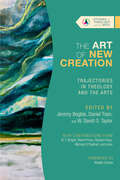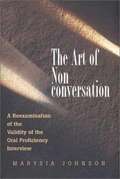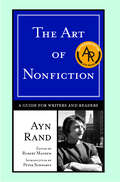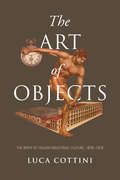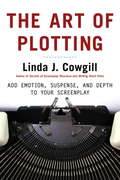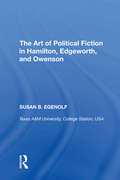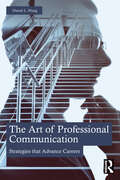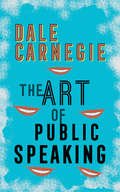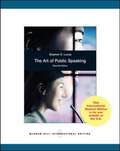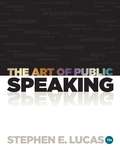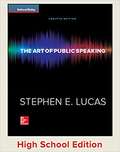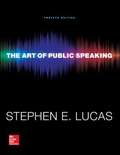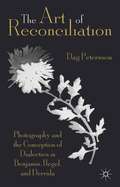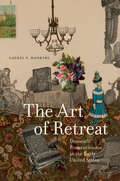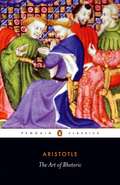- Table View
- List View
The Art of New Creation: Trajectories in Theology and the Arts (Studies in Theology and the Arts Series)
by Jeremy Begbie W. David O. Taylor Daniel Train, Jeremy Begbie, W. David O. Taylor Daniel TrainThe biblical themes of creation and new creation are inextricably bound to each other.
The Art of Non-Conversation: A Re-examination of the Validity of the Oral Proficiency Interview
by Marysia JohnsonThe purpose of this book is to provide answers to two fundamental questions. The first is a practical one, and it represents the main focus of the book: Is the Oral Proficiency Interview a valid instrument for assessing language speaking proficiency? The second is a theoretical one: What is speaking ability? (that is, speaking ability that exists independently of testing instruments).
The Art of Nonfiction
by Ayn RandRand's lectures take listeners step by step through the writing process. From preparing an outline to polishing a draft to mastering an individual writing style, this crucial resource introduces the ideas of one of our most enduring authors to a new generation.
The Art of Nonfiction: A Guide for Writers and Readers
by Ayn Rand Peter SchwartzA remarkable series of lectures on the art of creating effective nonfiction by one of the 20th century's most profound writers and thinkers--now available for the first time in print.Culled from sixteen informal lectures Ayn Rand delivered to a select audience in the late 1960s, this remarkable work offers indispensable guidance to the aspiring writer of nonfiction while providing readers with a fascinating discourse on art and creation. Based on the concept that the ability to create quality nonfiction is a skill that can be learned like any other, The Art of Nonfiction takes readers through the writing process, step-by-step, providing insightful observations and invaluable techniques along the way. In these edited transcripts, Rand discusses the psychological aspects of writing, and the different roles played by the conscious and unconscious minds. From choosing a subject to polishing a draft to mastering an individual writing style--for authors of theoretical works or those leaning toward journalistic reporting--this crucial resource introduces the words and ideas of one of our most enduring authors to a new generation.
The Art of Objects: The Birth of Italian Industrial Culture, 1878-1928 (Toronto Italian Studies)
by Luca CottiniThe Art of Objects is a cultural history of early Italian industrialism, set against the political, social, and intellectual background of post-unification Italy, and a cutting-edge investigation of the formation of Italy’s industrial culture at the turn of the 20th century. By adopting the unusual perspective of several objects of mass consumption, such as watches, photographs, bicycles, gramophones, cigarettes, and toys, author Luca Cottini examines their transformation from commercial items into aesthetic and philosophical icons. By focusing on the cultural significance of these objects, as they enter the market and appear in contemporary works of art and literature, The Art of Objects outlines a more comprehensive view of the age between the unification of Italy and Fascism, encompassing production and consumption, aesthetics and entrepreneurship, industry and the humanistic tradition. The observation of the slow formation of new languages, forms, practices, and experiences around these objects also provides an early documentation of the creative laboratory of Italy’s industrial culture. By reconstructing the origins of the Italian culture of design, the book ultimately investigates Italy’s critical reception of industrialism, the nation’s so-called “imperfect” modernization, and its ongoing quest for an original way to modernity.
The Art of Orality: Cultural Aesthetics in the Absence of Writing
by Declan LloydThis book considers how the presence or absence of writing can influence a culture&’s distinctive styles of visual art, proposing that many of the most profound developments in the art world are directly correlative with a cultural transition from orality to literacy (that is, from a culture which only has a spoken form of language, to one which has both a spoken and written form). The study contemplates how the &‘psychodynamics&’ of orality might radically affect artistic expression, resulting in a range of visual traits which in many ways reflect the unique modes of speech within primary oral societies. Looking to the art of a diverse range of cultures and time periods – including Archaic Greek art, medieval art, African tribal art, child art, Outsider art and Modern art – The Art of Orality considers what new insights can be gleaned by bringing these styles into dialogue with orality and literacy studies.
The Art of Perspective: Who Tells the Story (Art of...)
by Christopher CastellaniA writer may have a story to tell, a sense of plot, and strong characters, but for all of these to come together some key questions must be answered. What form should the narrator take? An omniscient, invisible force, or one--or more--of the characters? But in what voice, and from what vantage point? How to decide? Avoiding prescriptive instructions or arbitrary rules, Christopher Castellani brilliantly examines the various ways writers have solved the crucial point-of-view problem. By unpacking the narrative strategies at play in the work of writers as different as E. M. Forster, Grace Paley, and Tayeb Salih, among many others, he illustrates how the author's careful manipulation of distance between narrator and character drives the story. An insightful work by an award-winning novelist and the artistic director of GrubStreet, The Art of Perspective is a fascinating discussion on a subject of perpetual interest to any writer.
The Art of Picturing in Early Modern English Literature (Routledge Studies in Shakespeare)
by Sabatier Armelle Camilla CaporicciWritten by an international group of highly regarded scholars and rooted in the field of intermedial approaches to literary studies, this volume explores the complex aesthetic process of "picturing" in early modern English literature. The essays in this volume offer a comprehensive and varied picture of the relationship between visual and verbal in the early modern period, while also contributing to the understanding of the literary context in which Shakespeare wrote. Using different methodological approaches and taking into account a great variety of texts, including Elizabethan sonnet sequences, metaphysical poetry, famous as well as anonymous plays, and court masques, the book opens new perspectives on the literary modes of "picturing" and on the relationship between this creative act and the tense artistic, religious and political background of early modern Europe. The first section explores different modes of looking at works of art and their relation with technological innovations and religious controversies, while the chapters in the second part highlight the multifaceted connections between European visual arts and English literary production. The third section explores the functions performed by portraits on the page and the stage, delving into the complex question of the relationship between visual and verbal representation. Finally, the chapters in the fourth section re-appraise early modern reflections on the relationship between word and image and on their respective power in light of early-seventeenth-century visual culture, with particular reference to the masque genre.
The Art of Plotting: How to Add Emotion, Excitement, and Depth to Your Writing
by Linda J. CowgillPlot must be as much about the emotions of the characters as it is about the events of the story. That's the message of The Art of Plotting, which teaches screenwriters how to integrate plot, characterization, and exposition to make stories compelling. Using examples from recent and classic movies, author Linda J. Cowgill demonstrates how the plot springs naturally from the characters--and how that technique makes audiences connect with the story on a more intimate level. Easy exercises reveal common plot problems and help writers overcome them.
The Art of Political Fiction in Hamilton, Edgeworth, and Owenson: Gender And Glosses In The Romantic Period
by Susan B. EgenolfEven as Romantic-period authors asserted the importance of telling the unvarnished truth, novelists were deploying narrative glossing in particularly sophisticated forms. The author examines the artistic craft and political engagement of three major women novelists-Elizabeth Hamilton, Maria Edgeworth, and Sydney Owenson-whose self-conscious use of glosses facilitated their critiques of politics and society. All three writers employed devices such as prefaces and editorial notes, as well as alternative media, especially painting and drama, to comment on the narrative. The effect of these disparate media, the author argues, is to call the reader's attention away from the narrative itself. That is, such glossing or 'varnishing' creates narrative ruptures that offer the reader a glimpse of the process of fictional structuring and often reveal the novel's indebtedness to a particular historical moment. In spite, or perhaps because, of their being gendered feminine in eighteenth-century rhetorical commentary, therefore, these glosses allow women writers to participate in 'masculine' discussions outside the conventional domestic sphere. Informed by a wide range of archival texts and examples from the visual arts, and highlighting the 1798 Irish Rebellion as a major event in Irish and British Romantic writing, the author's study offers a new interdisciplinary reading of gendered and political responses to key events in the history of Romanticism.
The Art of Professional Communication: Strategies that Advance Careers
by Daniel PlungGoing beyond the mechanics of professional communication, this book combines insights into the overlooked implicit demands of corporate communication challenges with the proven strategies and techniques that distinguish professionals as capable communicators and candidates for promotion.The practical strategies offered in this book represent professional communication principles filtered through the lens of the author’s 40-year career, that enabled him to rise from an initial assignment as a technical editor to positions of senior management directing large, diverse business and technical organizations. Here, he has collected into one resource the reasoned and disciplined decision-making processes, tools, and techniques essential to craft communications, precisely attuned to the explicit and implicit expectations of each assignment and supported by a structure and presentation logic that delivers a totally responsive and accurately targeted product. This is an essential guide for all levels of professionals who recognize the need to distinguish themselves within a highly competitive career environment.Business professionals and instructors in corporate training programs, supervisors and managers, and students in professional communication programs will welcome this deep dive into the real-world challenges and opportunities in professional communication and the role effective communication plays in career advancement.
The Art of Public Speaking
by Dale CarnegieA pioneer in the field of self-help, Dale Carnegie distilled his experiences as a salesman and lecturer in this first guide to successful speech-making. The Art of Public Speaking is direct, practical advice for emphasizing ideas for easy comprehension and high impact ranges from finding an appropriate rhythm to conquering stage fright.Avoiding the use of tricks and shortcuts, the author suggests methods for developing one's thoughts in order to form an original, authentic manner of speaking. He advises speakers to practice their presentation skills, offering useful tips for speech-making in both personal and professional situations. First published in 1915, this classic continues to encourage people from all walks of life to overcome their self-consciousness and increase their effectiveness and comfort as public speakers.Penguin Random House Canada is proud to bring you classic works of literature in e-book form, with the highest quality production values. Find more today and rediscover books you never knew you loved.
The Art of Public Speaking
by Dale CarnegieThe bestselling author of How to Win Friends and Influence People shares the essentials for public speaking in this classic self-help guide.Good oral communication skills are critical in life. Whether you&’re speaking to an audience of one at a party or one hundred at a business conference, you must be able to get your point across effectively. In order to do that, you need a worthwhile topic and the knowledge of what makes a great public speaker.In The Art of Public Speaking, authors Dale Carnegie and J. Berg Esenwein lay out what readers need to improve their communication skills in both personal and professional settings. They offer advice on a multitude of topics, including overcoming stage fright, avoiding monotony, and showing enthusiasm. Learn about methods of delivery and the power of pitch, pace, and gestures. They also discuss strengthening your memory and expanding your vocabulary.The Art of Public Speaking was first published in 1915, but its message is still relevant today. With the help of practice and the lessons herein, readers will be on their way to wowing audiences.
The Art of Public Speaking
by Stephen E. LucasPresenting to the class or delivering a speech to a large crowd can create anxiety, fear, and stress. Adapted from the best-selling text, The Art of Public Speaking, First Canadian Edition, will equip readers with tools and strategies to allay their fears while captivating audiences in various contexts, from the classroom to the workplace. Stressing the importance of public speaking in both the academic career and in the workplace is a challenge as students often don't realize that writing for the ear is different than writing for the eye. The scope of the text includes different public speaking situations (e. g. , business meetings, web casting, teleconferencing, meetings, trade shows, etc. ). The Art of Public Speaking walks readers through the steps and skills involved in crafting and delivering effective oral presentations. Bringing the theory to life, the authors include numerous engaging Canadian examples relevant to a variety of disciplines and careers. Examples and speeches draw on current topical issues (free trade, corporate spying, genetically modified food, etc. ) that are important to Canadians and to post-secondary students. Whether a novice or a professional, every student will learn how to be a better public speaker through Lucas' clear explanations and thorough coverage. Ultimately, this text helps students learn practical oral communication skills that enable them to navigate through life with greater confidence to achieve personal and professional success.
The Art of Public Speaking
by Stephen LucasThe Art of Public Speaking 11e continues to define the art of being the best by helping today's students become capable, responsible speakers and thinkers. With a strong focus on the practical skills of public speaking and grounded in classical and contemporary theories of rhetoric, The Art of Public Speaking offers full coverage of all major aspects of speech preparation and presentation. Utilizing the full suite of resources, students learn to internalize the principles of public speaking, build confidence through speech practice, and prepare for success in the classroom and beyond. With the new Enhanced Speech Capture in Connect Lucas, instructors now have the ability to evaluate live speeches using a customizable rubric in the classroom. Instructors may also upload speech videos on students' behalf to create and manage true peer review assignments. With its ground-breaking adaptive learning system, Connect LucasTM also helps students "know what they know," while guiding them to experience and learn important concepts that they need to know to succeed. With McGraw-Hill CreateTM, instructors can now customize their Lucas 11e textbook to the section level, selecting and arranging only the sections covered in the course. The new Create system will automatically repaginate and re-number chapters, sections, graphs, and illustrations, based on how the instructor chooses to arrange them. This deep level of customization guarantees that students pay only for the content covered in the course.
The Art of Public Speaking (10th Edition)
by Stephen LucasIn preparing this edition, I have retained what readers have identified as the main strengths of previous editions. The book continues to be informed by classical and contemporary theories of rhetoric but does not present theory for its own sake. Keeping a steady eye on the practical skills of public speaking, it offers full coverage of all major aspects of speech preparation and presentation.
The Art of Public Speaking 12th Edition
by Stephen LucasThe Art of Public Speaking personalizes learning for every student no matter who they are or where they are, ensuring that they come to your public speaking class confident, prepared with the principle foundations, and ready to participate in your teaching and coaching. Connect is the only integrated learning system that empowers students by continuously adapting to deliver precisely what they need, when they need it, and how they need it, so that your class time is more engaging and effective.
The Art of Public Speaking: The Original Tool for Improving Public Oration
by Dale CarnegieBoost Your Skills and Confidence with This Classic GuideDo you have trouble getting up in front of an audience? Are you struggling to get your point across? Public speaking can be nerve-wracking, especially if you?re a naturally nervous person or if you?re under-prepared. Originally published in 1915, The Art of Public Speaking has been the go-to guide for those who want to better their speaking abilities for more than a century. Featured within this classic manual are hundreds of tips and tricks on how to become an efficient and effective public speaker. The sections included address: tone,delivery, enthusiasm, confidence, concentration, charm, precision, gesturing, preparation, and much more! Stop putting your audience to sleep. Pick up your copy of The Art of Public Speaking and learn to captivate any audience today!
The Art of Ramona Quimby: Sixty-Five Years of Illustrations from Beverly Cleary’s Beloved Books
by Anna KatzThe Art of Ramona Quimby celebrates the artists behind Beverly Cleary's inimitable Ramona Quimby series.The adventures of her iconic heroine have been brought to life by five different artists: Louis Darling, Alan Tiegreen, Joanne Scribner, Tracy Dockray, and Jacqueline Rogers.Readers can compare multiple interpretations of iconic scenes (remember the infamous egg-cracking incident?), read letters exchanged between Cleary and the first illustrator, and learn the stories behind the illustrations.• Celebrates the timeless work by these five artists since Beverly Cleary published the first Ramona Quimby book in 1955• Includes excerpts from the books• Two essays illuminate the series's narrative and artistic impactThe Art of Ramona Quimby explores the evolution of an iconic character, and how each artist has ultimately made her timeless.For fans of illustration and design, and for those who grew up alongside Ramona, this richly nostalgic volume reminds us why we fell in love with these books.• Beverly Cleary's bestselling children's series has sold over 50 million copies.• Great for readers who grew up with Ramona and Beezus, as well as parents, grandparents, and anyone who remembers reading these books when they were young• A must-have for fans of Beverly Cleary and the Ramona series, as well as anyone interested in illustrated character art and development over time• Perfect for those who loved The Secret Art of Dr. Seuss by Theodor Geisel, The Art of Eric Carle by Eric Carle, and Literary Wonderlands: A Journey Through the Greatest Fictional Worlds Ever Created by Laura Miller
The Art of Reconciliation
by Dag PeterssonDag Petersson offers a comprehensive critique of the philosophy that has dominated 200 years of modern thought, politics, economy, and culture. The basic question is this: why does dialectical metaphysics fail to keep what it promises? What is it about dialectics, that makes it fall into irreducibly distinct variations of itself, when all it promises is to synthesize, to reconcile and make whole what is fragmented and alien to itself? An undisciplined creativity intrinsic to completing reason comes to light through analyses of how dialectical systems begin. Every dialectical philosophy must account for its own birth, and it is at this point, when it also articulates its promise of universal synthesis, that the book discovers a desire for light-writing, or photography. Only the most immediate element light can mediate the necessary self-determination of thought at its origin. Light must begin to write. A philosophical critique of dialectics is therefore also a point of departure for a new aesthetic ontology of photography.
The Art of Retreat: Domestic Romanticisms in the Early United States (Transits: Literature, Thought & Culture, 1650-1850)
by Laurel V. HankinsThe political and cultural fantasy of home as a retreat from the pressures of the world first emerged in the U.S. alongside two major nineteenth-century literary movements: Romanticism and domestic fiction. Upending accepted gendered narratives from this period, The Art of Retreat posits that these movements originated from a domestic culture already in transition, in which home was frequently a more complicated site of self-interested pleasure, coerced labor, creole social reproduction, homosocial intimacy, bachelor whimsy, petty tyranny, racial abuse, and transgender capacity. The early national periodicals, sketches, and novels examined here lend themselves to this interpretation. Hankins argues that the literary tradition emerging from these decades—one that aligned creative genius with domestic retreat—reminds us that a politics that appeals to private feeling must reckon with new interpretations of labor, kinship, and reform in exchange for the promise of consensual citizenship. Published by Bucknell University Press. Distributed worldwide by Rutgers University Press.
The Art of Revision: The Last Word (Art of...)
by Peter Ho DaviesThe fifteenth volume in the Art of series takes an expansive view of revision—on the page and in lifeIn The Art of Revision: The Last Word, Peter Ho Davies takes up an often discussed yet frequently misunderstood subject. He begins by addressing the invisibility of revision—even though it’s an essential part of the writing process, readers typically only see a final draft, leaving the practice shrouded in mystery. To combat this, Davies pulls examples from his novels The Welsh Girl and The Fortunes, as well as from the work of other writers, including Flannery O’Connor, Carmen Machado, and Raymond Carver, shedding light on this slippery subject.Davies also looks beyond literature to work that has been adapted or rewritten, such as books made into films, stories rewritten by another author, and the practice of retconning in comics and film. In an affecting frame story, Davies recounts the story of a violent encounter in his youth, which he then retells over the years, culminating in a final telling at the funeral of his father. In this way, the book arrives at an exhilarating mode of thinking about revision—that it is the writer who must change, as well as the writing. The result is a book that is as useful as it is moving, one that asks writers to reflect upon themselves and their writing.
The Art of Rhetoric (Collins Classics Ser.)
by AristotleWith the emergence of democracy in the city-state of Athens in the years around 460 BC, public speaking became an essential skill for politicians in the Assemblies and Councils - and even for ordinary citizens in the courts of law. In response, the technique of rhetoric rapidly developed, bringing virtuoso performances and a host of practical manuals for the layman. While many of these were little more than collections of debaters' tricks, the Art of Rhetoric held a far deeper purpose. Here Aristotle (384-322 BC) establishes the methods of informal reasoning, provides the first aesthetic evaluation of prose style and offers detailed observations on character and the emotions. Hugely influential upon later Western culture, the Art of Rhetoric is a fascinating consideration of the force of persuasion and sophistry, and a compelling guide to the principles behind oratorical skill.
The Art of Scientific Storytelling: Transform Your Research Manuscript with a Step-by-Step Formula
by Rafael LunaWe all want our research to have an impact and to be cited by others. There are thousands of research articles published in our respective fields. How do we get someone to read our publications? This book shows you how to put your Title and Abstract into a story, along with the rest of your manuscript. Your research will stand out in a sea of peer-review publications, since it will be forged into a Scientific Story. As a research fellow in the laboratory of Professor Gerhard Wagner at Harvard Medical School, Dr. Luna was collaborating with four other top-notch laboratories in an interdisciplinary research effort to understand the end of the scanning mechanism required for protein synthesis in cells. They were sitting on a mound of research data collected by the various laboratories with varying expertise. This super-collaboration consisted of Physicists, Biologists, Structural Biologists, Biochemists, Chemists, a Computer Scientist, and a Chemical Engineer. There was so much data; yet they struggled to fashion a logical story for a peer-review publication. Dr. Luna was stuck. This book is written by an active research scientist, as a guide for other scientists doing research. This is how science should be written.
